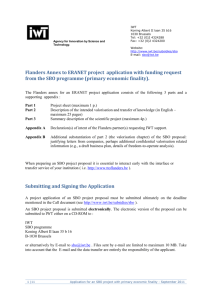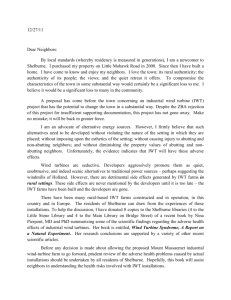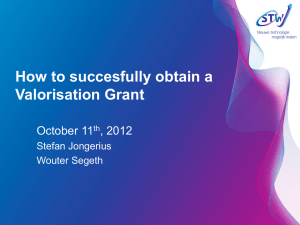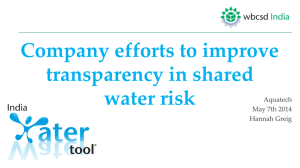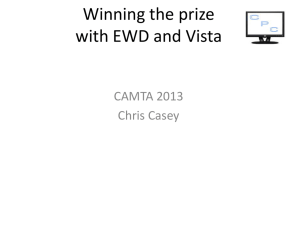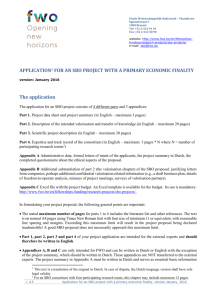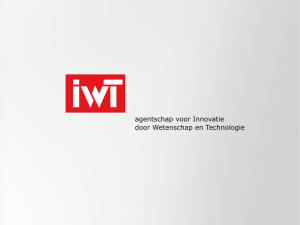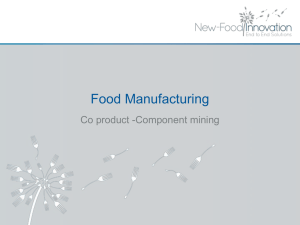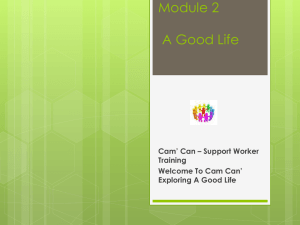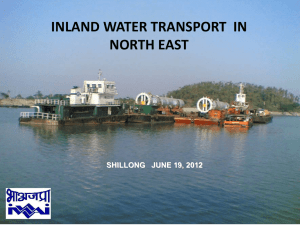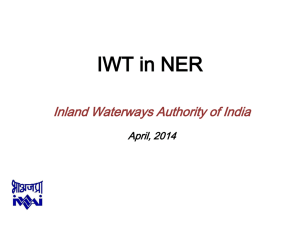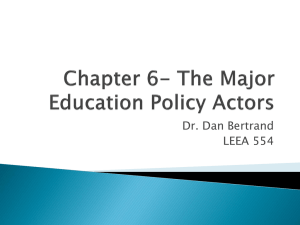here
advertisement
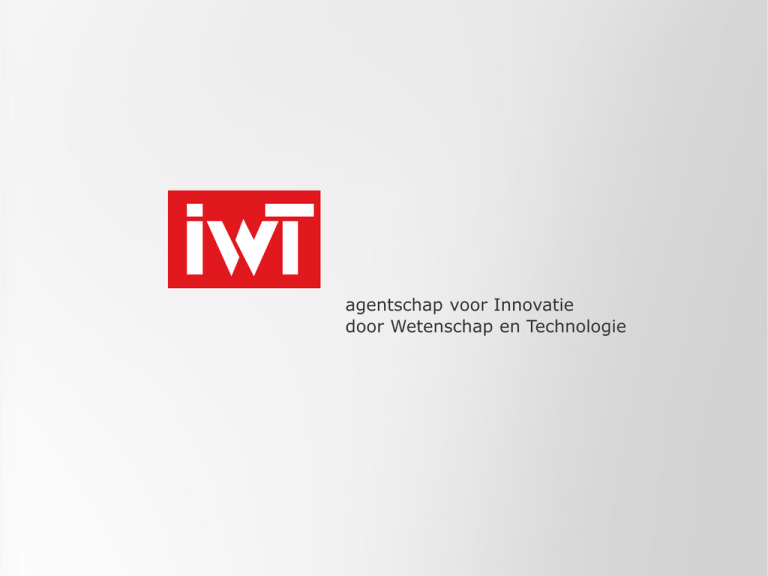
agentschap voor Innovatie door Wetenschap en Technologie agentschap voor Innovatie door Wetenschap en Technologie Presentation of the SBO-programme. This presentation contains only the key points of the SBOprogramme. For the actual preparation of a proposal it is essential to consult the appropriate SBO-Handbook and Application Form. All available information and documents relevant for the 2014-2015 SBO Call is available on : http://www.iwt.be/subsidies/sbo Overview. 1. Key characteristics of the SBO-programme. 2. Basic features. 3. General outline of a project proposal. 4. Evaluation process and framework. 5. Output monitoring of projects. 6. SBO in international collaborations. 7. Practical recommendations. 8. Additional information. 3 1. Key characteristics of the SBOprogramme Essence = realisation of strategic reseach investments. Two key aspects: 1. High-quality strategic basic research with a dedicated focus on high-risk, inventive and original research. 2. Strategic interest and extent of the valorisation perspectives in the longer term in Flanders (economic or social/societal). 4 1. Key characteristics of the SBOprogramme. strategic basic research” within SBO is not a goal in itself but an essential means to allow for an important new valorisation or knowledge utilisation. The SBO-programme is a cooperation oriented instrument; it requires an investment in the development of meaningful interactions and network building with users in the field i.e. companies (SBOE) or social/societal actors (SBO-M). 5 agentschap voor Innovatie door Wetenschap en Technologie ECONOMIC ACTORS (Companies) UNIVERSITIES /RESEARCH ORGANISATIONS SOCIAL OR SOCIETAL ACTORS (government entities, civil society organisations, social profit etc.) 1. Key characteristics of the SBOprogramme. Primary finality = main type of actors who can take up and use the scientific project results (actors = organisations external to the research organisations) SBO-economic finality = take up and use of the results primarily through economic actors (companies) with an economic value creation objective (i.e. employment + investments). SBO-social finality = take up and use of the results primarily through social/societal actors (e.g. government departments and agencies, civil society organisations, social profit sector) with a social value creation objective. 7 1. Key characteristics of the SBOprogramme. Challenges for applicants : 1)Demonstrate scientific potential and research approach. 2)Demonstrate valorisation potential and valorisation approach. • • active effort and commitment to enable the effective utilisation and valorisation of the research results by economic or social actors. meaningful synergy, interaction dynamics and mobilisation across institutional boundaries (research organisations, economic actors, social actors). i.e. substantial difference relative to “classic mechanisms” for the dissemination of academic research results 8 Es ist nicht genug zu wissen, man muss auch anwenden. Es ist nicht genug zu wollen, man muss auch tun Knowing is not enough, we must apply. Willing is not enough we must do. Goethe 9 1. Key characteristics of the SBOprogramme. Key economic valorisation strategies • Transfer of research results to existing companies; follow-up R&D activities Industrial advisory group (“begeleidingscommissie”) as an instrument • Transfer to a new to be founded spin-off company Key social/societal valorisation strategies. • Transfer of research results to existing organisationss; follow-up R&D activities Social/societal advisory group (“begeleidingscommissie”) as an instrument 10 1. Key characteristics of the SBOprogramme. Main adaptations over recent years To obtain a better valorisation orientation of the projects - With a better alignment between the supply-driven focus (from university research groups and research organisations) and the demand or problem-driven focus (from companies, social actors) - With earlier and more meaningful interactions and cooperations between researchers and the users (companies, social actors) from the early definition and design phase of the project proposal onwards > i.e. enabler for maintaining meaningful interaction dynamics over the lifecycle of the project 11 1. Key characteristics of the SBO-programme. Broader context : policy goal of co-creation, stronger cooperations between universities and industry. In 2014 : further finetuning of evaluation framework > feasibility of the valorisation approach -preparation phase (“voortraject”) -during the SBO-project (involvement, interaction dynamics) -after the SBO-project (follow-up R&D and implementation efforts) 12 1. Key characteristics of the SBOprogramme > Social programme part SBO social programme part – adaptations since 2013 Background : 2012 Impact analysis SBO programme (Social/societal finality). http://www.iwt.be/sites/default/files/SBO_impactanalys e_maatschapluik_2012.pdf 1) to strengthen the active participation of the social users community in the SBO project cycle; 2) to facilitate a more smooth transition between the end of the SBO-project and the further development and implementation pathway within the social user organisations. 13 1. Key characteristics of the SBOprogramme. Social programme part SBO social programme part – adaptations since 2013 • Evaluation framework : Strengthening of the importance of two-way interactions during proposal preparation, • Handbook for the participation of social user organisations. • Room for the active participation of social user organisations and the inclusion of more application oriented activities from the third project year onwards to bridge the gap between SBO-results and operational applications. + Advantage in selection process. 14 1. Key characteristics of the SBOprogramme. Tell me. I may listen. Teach me. I may remember. Involve me, and I will do it. Old Chinese wisdom 15 1. Key characteristics of the SBOprogramme. Important Guidance document : IWT’s policy guidelines on the use and transfer of the results of IWT-supported projects http://www.iwt.be/sites/default/files/subsidies/documenten/IWT_toelic htingsdoc_beleidslijn_resultaten_092009.pdf 16 2. Basic features. - Project proposers = open and accessable instrument for all Flemish R&Dactors (university associations, strategic research centres, other research organisations, companies etc…) + Optional involvement of R&D actors from abroad Perspective : useful knowledge transfer towards Flanders (i.e. to address “missing links” in essential expertise) and with a clear added value for the SBO-project (including valorisation objectives). 17 2. Basic features. - Project duration: maximum of 4 years - Project budget : see SBO-Handbook In practice (not as a standard) average in the order of magnitude of 1.0 - 2.0 million Euro (with exceptions to the order of 3 million Euro). IWT’s Cost model + budget template. Non-Flemish R&D-actors : maximum 20% of the project budget. 18 3. General outline of a project proposal. Part 1 Project sheet and project summary Part 2 Description of the intended valorisation and transfer of knowledge Part 3 Scientific project description Part 4 Expertise and track record of the consortium Appendix A Appendix B Use the application template taking into account the maximum requirements of the proposal length (i.e. eligibility criterion). “Less is more” 19 3. General outline of a project proposal. Important aspects of the application template. • Project proposals are only submitted electronically. • In additions further specifications have been added to the requested valorization description and to the content of Appendix B. In addition, applicants are urged not to add not wanted annexes. • The importance of early interactions with interface and transfer services is stressed (http://www.ttoflanders.be) 20 3. General outline of a project proposal. Important aspects of the application template. - Appendix B includes a term sheet (“afsprakennota”) between the partners of the consortium (i.e. mutual agreement on the budget and the personnel allocation, the management and the allocation of the IPR, and the vision and approach on the valorisation). This term sheet is prepared in close interaction with the TTO services and duly signed by a legal representative of the participating institutions . - The letter of intention of a company or organisation to participate in the advisory committee need to be duly signed by a legal representative of this company or organisation. 21 3. General outline of a project proposal. For the SBO economic programme part. Important aspects of the application template. For the SBO economic programme part: Mandatory input by all companies of the advisory committee (250 euro/year SME, 1000 euro/year for a company or other organisation). To be fulfilled at project submission and confirmed in letters of companies = eligibility requirement ! • “In kind” contribution can be accepted provided that this input is well substantiated. • Higher input is not obligatory but can be positively assessed in the evaluation of the proposal. • No obligation for spin-off earmarked projects. 22 3. General outline of a project proposal. For the SBO economic programme part. Lesson from earlier 2011-2012 call. Impact of the (then optional) financial input from companies in the economic programme part (excluding U2.2. evaluation criterion) With input from companies Without input from companies Total Number of proposals submitted 15 Number of projects supported 8 Average success rate 53% 16 2 13% 31 10 32% 23 3. General outline of a project proposal. For the SBO social programme part. SBO social programme part • NO eligibility condition for (cash/in kind) input • But focus on active participation and commitment of social user organisations + the inclusion of more application oriented activities from the third project year onwards to bridge the gap between SBO-results and operational applications (with advantage in selection process!). 24 4.Evaluation process and framework. 4.1. Evaluation process Round 1. Pre-selection. Round 2. Evaluation of the scientific quality S. utilisation/valorisation quality U. In each selection round : advice by the steering evaluation committees (“overkoepelende commissies OC’s) decision by IWT’s Board 25 4.Evaluation process and framework. 4.1. Evaluation process Inputs for the evaluation process : Round 1. Project proposal as submitted. Round 2. + written expert evaluation reports + written response from applicants +meeting and discussion with IWT staff on the valorisation/utilisation chapter +written supplement from applicants 26 4.Evaluation process and framework. 4.2. Evaluation framework Scientific quality(S ) Valorisation quality (U) -scientific potential -research approach -input-output balance -valorisation potential -valorisation approach -R&D capabilities -competence/track record -added value sustainability Expert evaluation guidelines and scoring and selection methodology available on IWTwebsite 27 4.Evaluation process and framework. Important points of attention. -Increased attention to the specific valorisation potential : shift from “generic platforms” towards more targeted problem-driven projects (“cloud of hail” versus “precision bullets”) -Increased attention to the intelligent composition of the (industrial or social/societal) advisory committee i.e. representative for the anticipated application areas, covering essential actors of the economic or social value chain; -Increased attention to the project preparation phase i.e. evidence of a dedicated process involving early and meaningful two-way interactions between researchers and users during the project definition phase; 28 4.Evaluation process and framework. Minimal requirements and ranking mechanism. - Minimal “reasonable” for both scientific quality S and valorisation quality U ( 6/10). - Projects which meet the minimal requirements are ranked in accordance with an equal weight for the scientific quality S and valorisation quality U scores. In case of projects with equivalent scores , a desirable diversity of application areas can be aimed for. 29 4.Evaluation process and framework. Minimal requirements and ranking mechanism. - Selection advantage for projects contributing to sustainable development. The main focus is the environmental dimension of sustainability. - (Maximum) quota for projects with a primary economic finality directed at the creation of a new to be founded spin-off company : max 20% of the budget allocated to the economic part of the SBO-programme. 30 5.Output monitoring of projects. Ex post project and portfolio assessment (A, B+, B-,C) -Scientific results -User involvement during the project -Exploitable results -Status of transfer and valorisation effects -Strategic economic or social/societal perspective for Flanders First Output monitoring report will be presented to IWT’s Board of Directors on October 16 2014. 31 6. SBO in international cooperations. •SBO internationalisation through ERANET-Joint programming actions (http://www.europrogs.be) e.g. M-ERA.NET on materials http://www.m-era.net next call to be launched in early 2015 Prior contact with staff of involved funding agencies strongly recommended 32 6. SBO in international cooperations. New in 2014 : Cooperation opportunity between Flanders and Netherlands : STW (OTP)-IWT (SBO) projects. =opportunity for scientific and valorisation added value e.g. complementary expertise, better coverage of value chain Topics 1) High tech systems and materials (including ICT and nanotechnology) 2) Chemistry and Farma (including biotechnology and biobased economy) 33 6. SBO in international cooperations. New in 2014 : Cooperation opportunity between Flanders and Netherlands : STW (OTP)-IWT (SBO) projects. • Available budget : 2,5 mio euro of IWT and STW each • Project budget : min. 0,6- max. 1 million Euro • Balanced/proportional research contribution and valorisation potential for Flanders and Netherlands; • Minimum 2 Flemish and 2 Dutch companies in advisory committee; Input by companies: 25% above 500.000 Euro. 34 6. SBO in international cooperations. New in 2014 : STW (OTP)-IWT (SBO) projects. • Importance of the “term sheet” • Lead agency approach : submission of proposals to STW for Topic 1 and to IWT for Topic 2; • Evaluation process according to two-stage procedure: • • • Stage 1 : Extended eligibility by both agencies; Stage 2 : Evaluation by lead agency Funding decisions by Board of Directors of both agencies • Prior contact with staff of STW and IWT is strongly recommended 35 7. Practical recommendations when preparing a proposal. • “Origination process” of an SBO-proposal is different from a “classic” academic research proposal. • Key importance of meaningful two-way dialogue and interaction between researchers from the early project conception onwards and over the entire project life cycle. • Need to think beyond the end date of the SBO-project. Let users elaborate on follow-up R&D and implementation interests and opportunities. • Valorisation is not just “dissemination”. • User involvement is not just “claiming being interested”. 36 7. Practical recommendations when preparing a proposal. • Be prepared to invest adequate time and effort in the proposal preparation process. Start early. Adopt a project management approach. • Interact early, systematic and according to plan with potential partners and economic or social/societal users. Discuss project scope + cooperation principles + valorisation intentions. • Also early interactions with university interface or transfer services are essential. • Ensure a good coherence between the scientific part and the valorisation part of your proposal. 37 8. Additional information. • IWT advisors will be available for an exploratory meeting (“verkennend gesprek”) on Friday October 24 and on Monday November 3 for the various finality areas and application sectors. • Potential applicants can make a request for an exploratory meeting at IWT until October 17 2014 for the meeting day of October 24, and until October 24 2014 for the meeting day of November 3. This can be done by E-mail to sbo@iwt.be together with a short abstract and the most important questions (max. 1 A4 p.). 38 8. Additional information. • SBO contact persons http://www.iwt.be/subsidies/sbo Paul Schreurs (SBO economic) ps@iwt.be Michèle Oleo (SBO social) mo@iwt.be -STW contact person http://www.stw.nl Ron Winkler (STW) r.winkler@stw.nl -IWT contact persons for key domains : Mia Callens (biotechnology) mc@iwt.be Veerle Cauwenbergh (materials) vc@iwt.be Carine Lucas (ICT) cl@iwt.be http://www.iwt.be/overiwt/medewerkers/adviseur 39 agentschap voor Innovatie door Wetenschap en Technologie Koning Albert II-laan 35, bus 16 B-1030 Brussel Tel.: +32 (0)2 432 42 00 Fax.: +32 (0)2 432 43 99 E-mail: info@iwt.be www.iwt.be
